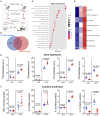(Pro)renin Receptor Inhibition Reduces Plasma Cholesterol and Triglycerides but Does Not Attenuate Atherosclerosis in Atherosclerotic Mice
- PMID: 35004870
- PMCID: PMC8739895
- DOI: 10.3389/fcvm.2021.725203
(Pro)renin Receptor Inhibition Reduces Plasma Cholesterol and Triglycerides but Does Not Attenuate Atherosclerosis in Atherosclerotic Mice
Abstract
Objective: Elevated plasma cholesterol concentrations contributes to ischemic cardiovascular diseases. Recently, we showed that inhibiting hepatic (pro)renin receptor [(P)RR] attenuated diet-induced hypercholesterolemia and hypertriglyceridemia in low-density lipoprotein receptor (LDLR) deficient mice. The purpose of this study was to determine whether inhibiting hepatic (P)RR could attenuate atherosclerosis. Approach and Results: Eight-week-old male LDLR-/- mice were injected with either saline or N-acetylgalactosamine-modified antisense oligonucleotides (G-ASOs) primarily targeting hepatic (P)RR and were fed a western-type diet (WTD) for 16 weeks. (P)RR G-ASOs markedly reduced plasma cholesterol concentrations from 2,211 ± 146 to 1,128 ± 121 mg/dL. Fast protein liquid chromatography (FPLC) analyses revealed that cholesterol in very low-density lipoprotein (VLDL) and intermediate density lipoprotein (IDL)/LDL fraction were potently reduced by (P)RR G-ASOs. Moreover, (P)RR G-ASOs reduced plasma triglyceride concentrations by more than 80%. Strikingly, despite marked reduction in plasma lipid concentrations, atherosclerosis was not reduced but rather increased in these mice. Further testing in ApoE-/- mice confirmed that (P)RR G-ASOs reduced plasma lipid concentrations but not atherosclerosis. Transcriptomic analysis of the aortas revealed that (P)RR G-ASOs induced the expression of the genes involved in immune responses and inflammation. Further investigation revealed that (P)RR G-ASOs also inhibited (P)RR in macrophages and in enhanced inflammatory responses to exogenous stimuli. Moreover, deleting the (P)RR in macrophages resulted in accelerated atherosclerosis in WTD fed ApoE-/- mice. Conclusion: (P)RR G-ASOs reduced the plasma lipids in atherosclerotic mice due to hepatic (P)RR deficiency. However, augmented pro-inflammatory responses in macrophages due to (P)RR downregulation counteracted the beneficial effects of lowered plasma lipid concentrations on atherosclerosis. Our study demonstrated that hepatic (P)RR and macrophage (P)RR played a counteracting role in atherosclerosis.
Keywords: (Pro)renin receptor (PRR); V-ATPase = vacuolar H+-adenosine triphosphatase; cholesterol; macrophage; renin- angiotensin system.
Copyright © 2021 Ye, Yang, Ren, Lu, Sun, Lin, Tan, Wang, Nguyen, Bader, Mullick, Danser, Daugherty, Jiang, Sun, Li and Lu.
Conflict of interest statement
AM is an employee and shareholder of Ionis Pharmaceuticals. The remaining authors declare that the research was conducted in the absence of any commercial or financial relationships that could be construed as a potential conflict of interest.
Figures




Similar articles
-
(Pro)renin Receptor Inhibition Reprograms Hepatic Lipid Metabolism and Protects Mice From Diet-Induced Obesity and Hepatosteatosis.Circ Res. 2018 Mar 2;122(5):730-741. doi: 10.1161/CIRCRESAHA.117.312422. Epub 2018 Jan 4. Circ Res. 2018. PMID: 29301853 Free PMC article.
-
Liver-selective γ-secretase inhibition ameliorates diet-induced hepatic steatosis, dyslipidemia and atherosclerosis.Biochem Biophys Res Commun. 2020 Jul 5;527(4):979-984. doi: 10.1016/j.bbrc.2020.04.157. Epub 2020 May 18. Biochem Biophys Res Commun. 2020. PMID: 32439159 Free PMC article.
-
Effects of coexpression of the LDL receptor and apoE on cholesterol metabolism and atherosclerosis in LDL receptor-deficient mice.J Lipid Res. 2001 Jun;42(6):943-50. J Lipid Res. 2001. PMID: 11369802
-
Effect of macrophage-derived apolipoprotein E on hyperlipidemia and atherosclerosis of LDLR-deficient mice.Biochem Biophys Res Commun. 2004 Apr 23;317(1):223-9. doi: 10.1016/j.bbrc.2004.03.037. Biochem Biophys Res Commun. 2004. PMID: 15047172
-
Constitutive androstane receptor activation decreases plasma apolipoprotein B-containing lipoproteins and atherosclerosis in low-density lipoprotein receptor-deficient mice.Arterioscler Thromb Vasc Biol. 2011 Oct;31(10):2232-9. doi: 10.1161/ATVBAHA.110.222497. Epub 2011 Jul 21. Arterioscler Thromb Vasc Biol. 2011. PMID: 21778422 Free PMC article.
Cited by
-
Soluble (pro)renin receptor as a novel laboratory biomarker of atherosclerosis.Acta Biochim Biophys Sin (Shanghai). 2024 Oct 10;57(3):501-504. doi: 10.3724/abbs.2024150. Acta Biochim Biophys Sin (Shanghai). 2024. PMID: 39394818 Free PMC article. No abstract available.
-
The Regulatory Impact of CFLAR Methylation Modification on Liver Lipid Metabolism.Int J Mol Sci. 2024 Jul 19;25(14):7897. doi: 10.3390/ijms25147897. Int J Mol Sci. 2024. PMID: 39063139 Free PMC article.
References
LinkOut - more resources
Full Text Sources
Molecular Biology Databases
Miscellaneous

